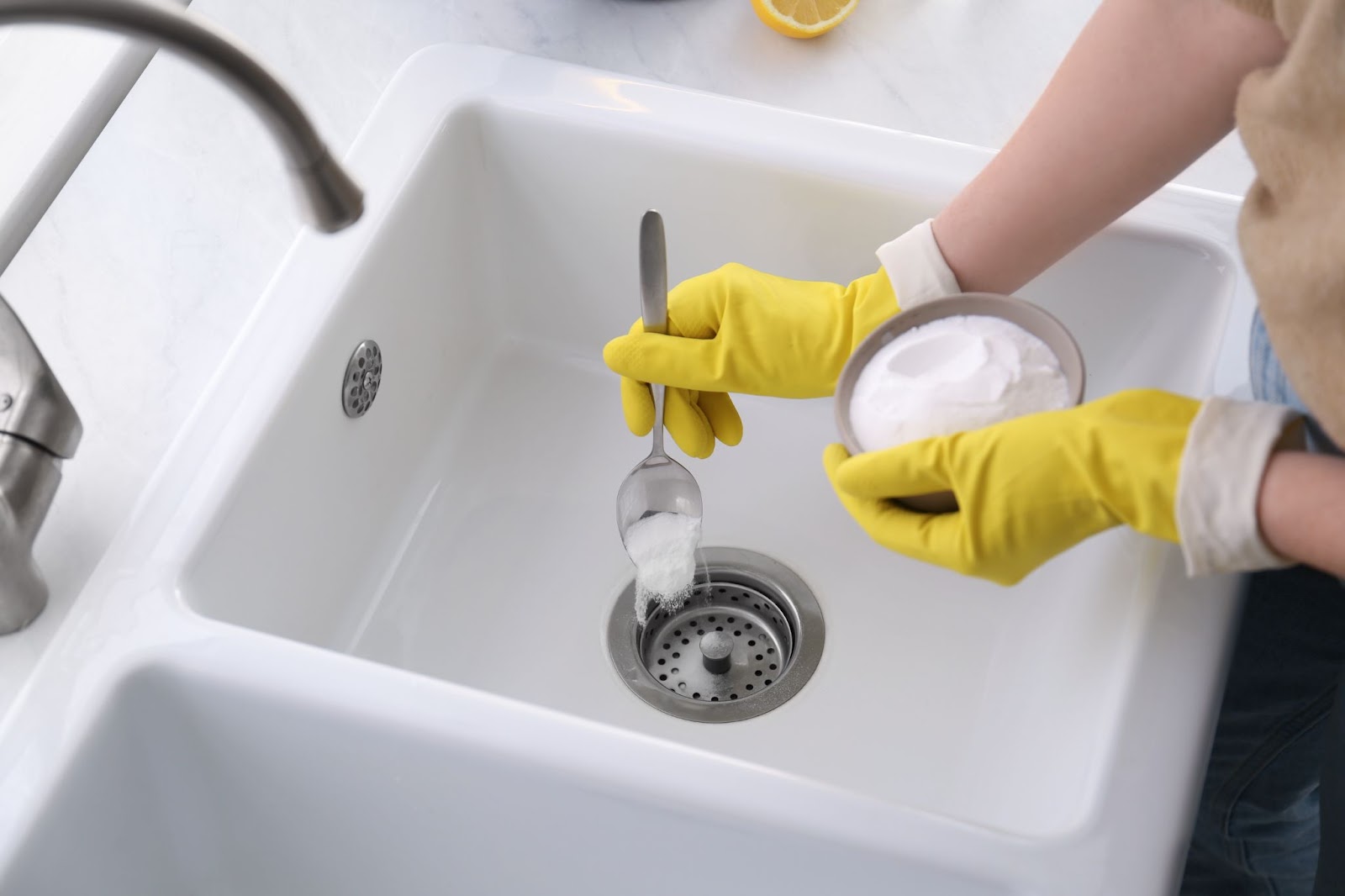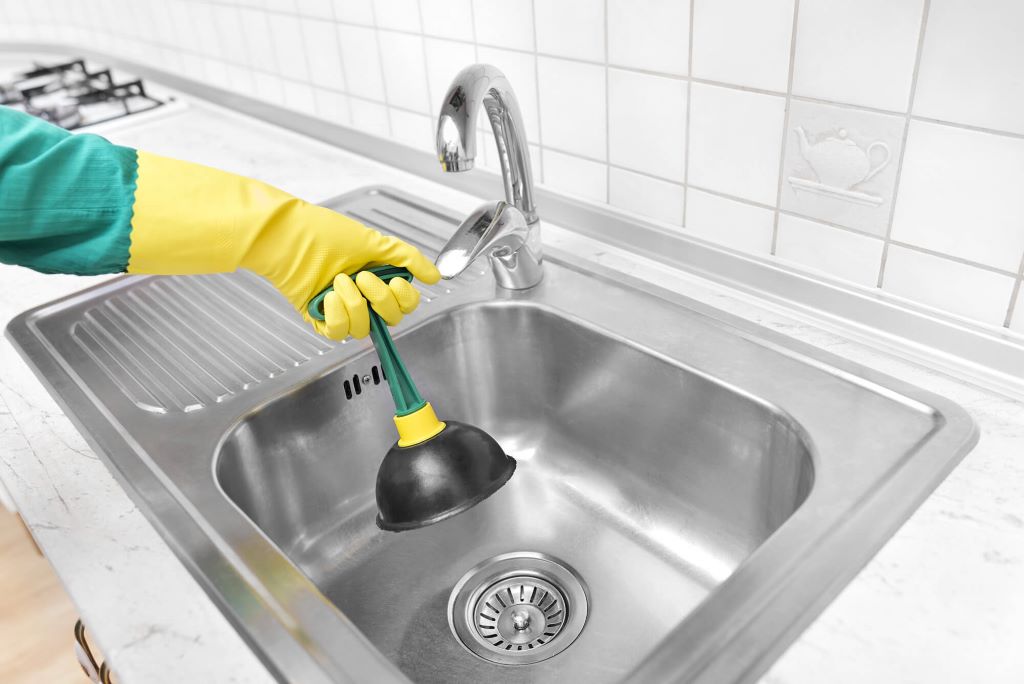Clogged and dirty sink drains are a common nuisance in most households. Over time, accumulations of food particles, soap scum, hair, and other debris can slowly build up inside the pipes, causing water to drain sluggishly or even lead to a full clog. But have no fear – clearing out a sink drain is usually a quick and straightforward process. With some simple tools, the right techniques, and a little elbow grease, you can have your sink draining freely in no time. Let’s start by covering how to clean sink drain.
Gather the Proper Supplies
Before tackling a clogged drain, assemble some go-to tools to help clear the blockage without damaging the pipes. You likely have lots of these already under your sink or can easily grab them at any hardware store. Key items to have on hand include:
- Plunger – The suction created can loosen clogs close to the drain. Pick a size that properly fit over and seal off the drain outlet.
- Drain snake/auger – Feeding a long, coiling metal snake down the pipes lets you hook and dislodge stubborn clogs deeper in the drain line. Hand-crank and electric-powered options are available.
- Baking soda and vinegar – This classic chemical reaction creates a bubbling foam that can help break up gunk and clear soft clogs along the pipes
- Bucket – Useful for catching drips and the yucky stuff you remove from the drain. Also lets you collect and pour a large volume of water to flush the drain.
- Goggles – Protect your eyes from splashing liquids or debris. Safety first!
You may also want pipe brushes, gloves, or other specialty drain tools, but this covers the basics to handle most easy clogs. Pro tip: Lay out some old towels to kneel on and catch spills!

Diagnose the Drain Issue
Not all clogged drains are created equal, so take a moment to diagnose where and what type of clog you’re dealing with before blindly trying to force it open. Check these areas:
Is the Sink Backing Up? If water pools are higher than normal or overflow without draining, the clog is likely deeper in the main drain line. You’ll need to snake it.
Is the Water Draining Slow? A sluggish but still functional drain points to a partial clog closer to the drain itself that a plunger may uncork.
Is the Sink Only Affected? An isolated issue indicates something likely stuck in the fixture’s piping rather than the wall drainage pipes also tied to other sinks, tubs or drains. Focus efforts only on this sink.
What Does the Drain Look Like? Peer down into the drain. The gunk visible around the mouth hints at a clog down below. Watch water swirl as you slowly pour it in – spinning means it’s following a clear path rather than pooling up.
Answering questions like these will help zero in on why water’s not properly draining and how to devise your attack plan. Don’t just start plunging away without a strategy! Know your enemy.
Attempt a DIY Drain Cleaning
Sinks generally clog in a couple of key areas – the curved P-trap pipe underneath the sink, which catches debris but gets blocked over time, or further down the drain line where grease, soap scum, and other gunk accumulates and sticks to the pipe walls. Different techniques are required to clear each spot. We’ll go after the P-trap first since it’s easier to access.
Cleaning the P-Trap
The u-shaped pipe piece located underneath the sink can be unscrewed completely (a bucket underneath will catch any water spilled). Check inside and clean off any stuck-on gunk or trapped items with a pipe brush. While detached, run water through the pipes on either side to flush them out.
Also, consider boiling the P-trap for a few minutes in a pot on your stove – the heat will help melt and loosen globs of grease that may be caught in there.
Using a Plunger
If water still won’t drain smoothly, your next line of attack is a regular sink plunger. After wetting the rounded cup and sink, drain with water to form a tight seal, and work the plunger up and down with vigorous, quick motions. The suction can loosen blockages reasonably close to the drain opening. Repeat for several minutes to pressurize the pipe and dislodge the clog bit by bit.
Baking Soda and Vinegar
For soft partial clogs along the pipe farther than a plunger can reach, dump about 1/2 cup baking soda down the drain, followed by 1 cup heated white vinegar. Close with a sink stopper. The chemical reaction between acid and base creates foam and bubbles that break up gunk lining the pipes. Let it sit 5-10 minutes before running hot water for a few more minutes to flush debris. A second treatment may help clear lingering blocks.
Using a Drain Snake
If DIY attempts fail and water still pools slowly or not at all in your sink basin, the clog has likely migrated too far down the drain line for easy access. It’s time to call in the big guns – a drain auger snake. Feed the coiled metal wire down the drain and twist clockwise once hitting resistance to coil through the clog and pull it back. Be patient while working through tough obstructions. Running hot water periodically will help wash away particles that break free deeper inside.
Warning – a loose snake inside the angled elbow of the P-trap may poke its way through into the sink bowl if you’re too forceful. Easy does it here. Retrieve carefully if this happens.
Avoid Harsh Chemical Drain Cleaners
You may be tempted to dump industrial-strength chemicals like sulfuric acid or sodium hydroxide down your drain, but don’t do it! These reactive agents can corrode or even melt pipes and plumbing over time, not to mention giving off toxic fumes. An emergency plumber visit is much safer for your pipes than risking chemical damage.
Prevent Future Sink Clogs
Cleaning a current drain issue is half the battle – taking steps to avoid a repeat blockage is just as key. Am I right? Nobody wants to regularly snake their sink drains if they can avoid it. So lend me your ears as I drop some knowledge for keeping your pipes clear long-term:
Use a Drain Catch
Install mesh sink drain catchers over or in each fixture’s opening to trap stray hair, gunk and other debris before it washes down into your pipes. Just the simple act of preventing buildup in the first place saves tons of effort.
Empty and clean these filters out regularly when you notice heavy debris accumulating. Clogs form gradually over time, so don’t give them a chance to start! An ounce of prevention is worth a pound of cure, after all.

Mind Your Sink Habits
Be aware that fat/grease and starchy foods rinsed off plates can quickly coat pipes between your sink and main sewer line. Avoid pouring fats directly down drains – dry wipe dishes first. Put strainers in place if washing lots of food particles down.
Limit the use of garbage disposal that can grind rather than dissolve scraps – this mainly just relocates chunks farther down pipes. Compost vegetable food waste instead.
And easy on the hairspray, mousse or thick conditioners in the sink basin – move hair care to the shower when possible to contain the mess.
Flush Regularly
Make it routine to flush your less-used drains, such as basement, laundry or spare bath sinks, once a week minimum by running very hot water for 30-60 seconds. This maintains flow, prevents drying or adhesion inside pipes, and pushes any loose particles down the main drain.
Also, pour a cup each of baking soda and vinegar down once a month. Let it bubble and foam for 5 minutes before rinsing the drain. This cleans soap scum and breaks up any small clogs forming.
And no need to spend money on enzyme cleaner tablets or liquids – plain hot water works just fine for preventive care!
Know When to Call a Professional
While many sink clogs can be cleared with some elbow grease, know when to call for backup. Issues involving main sewer lines, multiple affected drains, outdoor cleanouts, or a history of repeat issues likely require professional hydro jet drain cleaning equipment and experienced skills. Leaks also demand a visit from the pros.
Most plumbers offer affordable drain cleaning house calls before trying invasive pipe repairs – and you can watch their methods for next time!
Last Words
I hope these crash tips on how to clean sink drain give you a new confidence to tackle that slow drain yourself instead of reaching for the phone book next time your sink backs up.
Remember – gather the right gear suited for your unique clog, assess the drain to pick an approach, try less disruptive fixes first, and then escalate tactics as needed when installing a washing machine drain pipe. Control the chaos!
Stay clean and green by reusing handy homemade ingredients before resorting to harsh chemical cleaners. And most importantly, keep ahead of problems by instilling good sink habits daily.
FAQs
Q: How often should I clean my sink drain?
A: You should clean your sink drain every 1-2 weeks to prevent clogs and odors.
Q: What are the signs that my sink drain needs cleaning?
A: Signs that your sink drain needs cleaning include:
- Slow draining
- Unpleasant odors
- Visible debris or grime in the drain
Q: What are the best methods for cleaning a sink drain?
A: There are several effective methods for cleaning a sink drain, including:
- Boiling water: Pour a pot of boiling water down the drain. This will help to dissolve grease and soap scum.
- Baking soda and vinegar: Pour 1/2 cup of baking soda down the drain, followed by 1/2 cup of white vinegar. The baking soda and vinegar will react to create a fizzing action that can help to clean the drain.
- Drain cleaner: If the above methods do not work, you can try using a commercial drain cleaner. However, it is important to use drain cleaners sparingly and according to the manufacturer’s instructions.
Q: What can I do to prevent clogs from forming in my sink drain?
A: There are several things you can do to prevent clogs from forming in your sink drain, including:
- Avoid pouring grease or oil down the drain.
- Use a drain strainer to catch food scraps and other debris.
- Regularly clean your sink drain using one of the methods mentioned above.
Q: Is it safe to use a plunger to clean a sink drain?
A: Yes, it is safe to use a plunger to clean a sink drain. However, it is important to use a plunger that is specifically designed for sinks, as plungers for toilets are not strong enough to dislodge clogs in sink drains.




